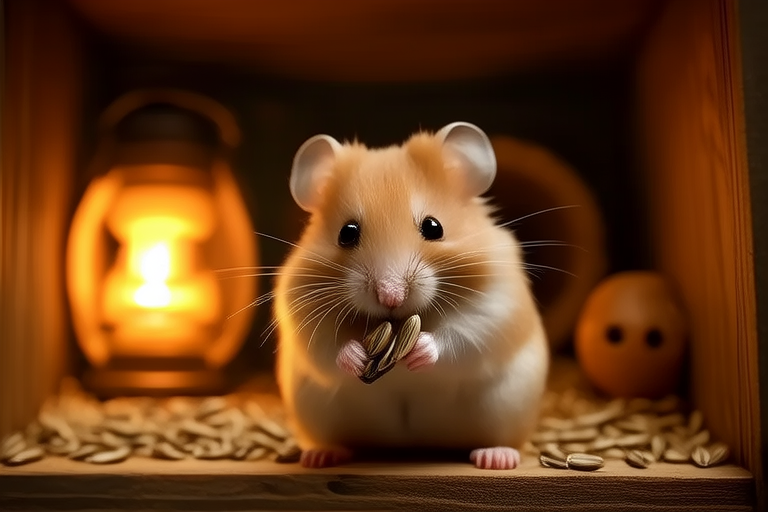The Secret Nighttime Lives of Golden Hamsters
Golden hamsters, also known as Syrian hamsters, are nocturnal creatures that spend most of their active hours under the cover of darkness. While their daytime hours are often spent resting, their nighttime routines are rich with activity, offering fascinating insights into their behavior and needs. Understanding these behaviors is crucial for pet owners who wish to provide optimal care and enrich their hamsters’ living conditions.
Eating Patterns
During the night, golden hamsters embark on a series of eating sprees, which are vital for maintaining their energy levels throughout the day. These tiny creatures have a unique habit of hoarding food, storing it in various corners of their enclosure. They use their paws to carry seeds, pellets, and fresh vegetables back to their preferred hiding spots. This behavior stems from their wild ancestors, who needed to store food for leaner times.
Owners may notice that their hamsters consume a variety of foods, including commercial hamster pellets, fresh fruits, and vegetables. However, it’s essential to ensure that the diet is balanced and nutritious. Providing a mix of high-quality pellets and fresh produce ensures that your hamster gets all the necessary vitamins and minerals.
Sleeping Positions
When not engaged in eating or exploring, golden hamsters seek out cozy nooks to sleep. They prefer enclosed spaces that mimic the burrows they would inhabit in the wild. In captivity, this could be a hammock, a cardboard box, or even a specially designed sleeping house. Once they find their ideal spot, they curl up into a ball, tucking their heads between their hind legs. This position not only keeps them warm but also protects them from potential threats.
Hamsters can sleep for extended periods, sometimes up to 12 hours at a time. During deep sleep, they enter a state of torpor, where their metabolic rate slows down significantly. This allows them to conserve energy, especially if food resources are scarce. Owners should respect their hamsters’ need for uninterrupted sleep by minimizing disturbances during the night.
Exercise Routines
Physical activity is an essential part of a hamster’s nighttime routine. They engage in various forms of exercise, such as running on their exercise wheels, climbing on toys, and digging tunnels. The exercise wheel is a favorite among hamsters, providing an opportunity for them to burn off excess energy and maintain muscle tone.
In addition to the exercise wheel, owners can enrich their hamsters’ environment by providing tunnels, ladders, and platforms. These items stimulate their natural instincts to explore and forage. Regular physical activity is crucial for preventing obesity and ensuring overall health.
Social Interactions with Other Hamsters
Golden hamsters are solitary animals by nature, and introducing multiple hamsters to the same enclosure can lead to aggressive behavior. In the wild, they live alone, defending their territory against intruders. This territorial instinct remains strong in domesticated hamsters, making it important for owners to provide each hamster with its own space.
Despite their solitary tendencies, hamsters can display social behaviors when interacting with their owners. Many hamsters enjoy being handled and will approach their owners for attention. Some may even develop a bond with their human companions, showing signs of affection through gentle nuzzles and purring sounds. However, it’s essential to handle them gently and avoid startling them, as sudden movements can cause stress.
Peculiar Habits Observed in Controlled Environments
Observations in controlled environments have revealed several peculiar habits of golden hamsters. One notable behavior is their tendency to groom themselves meticulously. They use their front paws to clean their fur, paying special attention to their faces and ears. This grooming ritual helps them stay clean and comfortable, as well as signaling to other hamsters that they are healthy and well-maintained.
Another interesting habit is their ability to navigate mazes. In experiments, hamsters have demonstrated impressive spatial memory, remembering the layout of complex mazes and finding shortcuts. This cognitive ability highlights their intelligence and adaptability, suggesting that providing mental stimulation is just as important as physical exercise.
The Importance of Understanding These Behaviors
Understanding the behaviors, habits, and secret activities of golden hamsters is essential for providing optimal care and enriching their living conditions. By recognizing their eating patterns, sleeping positions, exercise routines, and social interactions, owners can create an environment that meets their hamsters’ needs and promotes their well-being.
Providing appropriate housing is the first step in ensuring a happy and healthy hamster. A spacious cage with plenty of room to move around is crucial, as is the inclusion of toys, tunnels, and other enrichment items. Regular cleaning and maintenance of the cage are also important to prevent the buildup of bacteria and odors.
Owners should also pay attention to their hamsters’ body language and behavior. Signs of distress, such as excessive grooming or lethargy, may indicate underlying health issues. Consulting a veterinarian is recommended if any concerning symptoms arise.
Captivating Readers with Engaging Language
The nighttime lives of golden hamsters are filled with intrigue and wonder. From their midnight feasts to their cozy sleeping positions, these little creatures lead lives full of activity and purpose. By delving into their secret world, we gain a deeper appreciation for their unique behaviors and the importance of providing them with a stimulating and nurturing environment.
Whether you’re a seasoned hamster owner or a curious newcomer, understanding the private lives of these small pets offers a window into their fascinating world. With a little knowledge and effort, you can ensure that your hamster enjoys a fulfilling and joyful existence, thriving in the company of its human caretaker.
